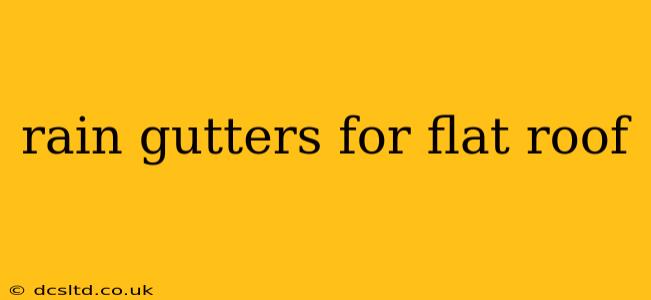Flat roofs, while modern and aesthetically pleasing, present unique challenges when it comes to water management. Unlike sloped roofs that rely on gravity to shed water, flat roofs require a carefully designed system to prevent water from pooling and causing leaks, damage, and costly repairs. This is where the right rain gutter system becomes crucial. This guide will explore the various options available for effective water management on flat roofs, addressing common questions and concerns.
What type of gutters are best for a flat roof?
The best gutter system for a flat roof differs significantly from those used on sloped roofs. Gravity doesn't assist, so the system needs to actively move water away from the building. This typically involves a combination of:
-
Internal Gutters: These are integrated into the roof's design and are often hidden from view. They consist of channels or troughs built into the roof itself, directing water to downspouts. This is a highly effective, aesthetically pleasing solution for new builds or major renovations.
-
External Gutters: While less common on flat roofs due to aesthetic considerations, external gutters can still be used effectively, particularly for smaller structures or retrofits. They require careful planning to ensure proper slope and drainage. These might be surface-mounted or attached to a slightly raised edge.
-
Specialized Drainage Systems: For larger flat roofs, a more complex system might be necessary, incorporating scuppers (openings in the parapet wall) or drains connected to underground piping. These systems are often designed by professionals specializing in flat roof drainage.
How do gutters work on a flat roof?
The effectiveness of gutters on a flat roof depends on creating a slight slope, even if imperceptible to the naked eye. This slope ensures that water flows consistently towards the drainage points. Several methods achieve this:
-
Built-in Slope: During construction, the roof's decking is laid with a slight slope towards the drainage points, often using a tapered insulation layer.
-
Internal Drainage Channels: Internal gutters are designed with a built-in slope to guide water towards the downspouts.
-
External Gutter Slope: For external gutters, a slight slope is achieved by using adjustable brackets or by carefully positioning the gutter itself. This requires precision to ensure proper drainage.
-
Gravity-Assisted Systems: While less common, some systems utilize small pumps or gravity-fed troughs to aid in water removal, especially when dealing with larger flat roof areas.
How much does it cost to install gutters on a flat roof?
The cost of installing gutters on a flat roof varies widely depending on several factors:
- Roof size and complexity: Larger roofs naturally require more materials and labor.
- Gutter type: Internal gutters are generally more expensive to install than external gutters due to their integration into the roof structure.
- Material choice: Different materials (e.g., aluminum, copper, zinc) impact the overall cost.
- Labor costs: Regional variations in labor rates significantly affect the final price.
It's best to obtain multiple quotes from reputable roofing contractors specializing in flat roof systems to get an accurate cost estimate for your specific situation.
How to prevent flat roof leaks?
Preventing flat roof leaks involves more than just gutters; it's a holistic approach to water management:
- Regular inspections: Regularly inspect your roof for any signs of leaks, damage, or debris buildup.
- Proper installation: Ensure all roofing components, including the gutters and drainage systems, are installed correctly by qualified professionals.
- Maintenance: Clean gutters regularly to remove debris that could impede water flow.
- High-quality materials: Choose durable, high-quality materials for your roof and gutter system to maximize their lifespan.
- Proper slope: A consistent, even slope across the roof is crucial to prevent pooling.
What are the advantages of a flat roof?
While flat roofs pose challenges in water management, they also offer several benefits:
- Cost-effective: Flat roofs are generally less expensive to construct than sloped roofs.
- Energy efficiency: They can provide superior insulation and energy savings, especially with the use of appropriate roofing membranes.
- Versatile: They are well-suited for rooftop gardens, solar panels, and other applications.
- Modern aesthetics: Many find their sleek, minimalist design appealing.
By understanding the unique requirements of flat roof drainage and investing in a well-designed and properly maintained gutter system, you can protect your building from water damage and enjoy the benefits of this increasingly popular roofing style. Remember to always consult with experienced roofing professionals for proper design and installation.
